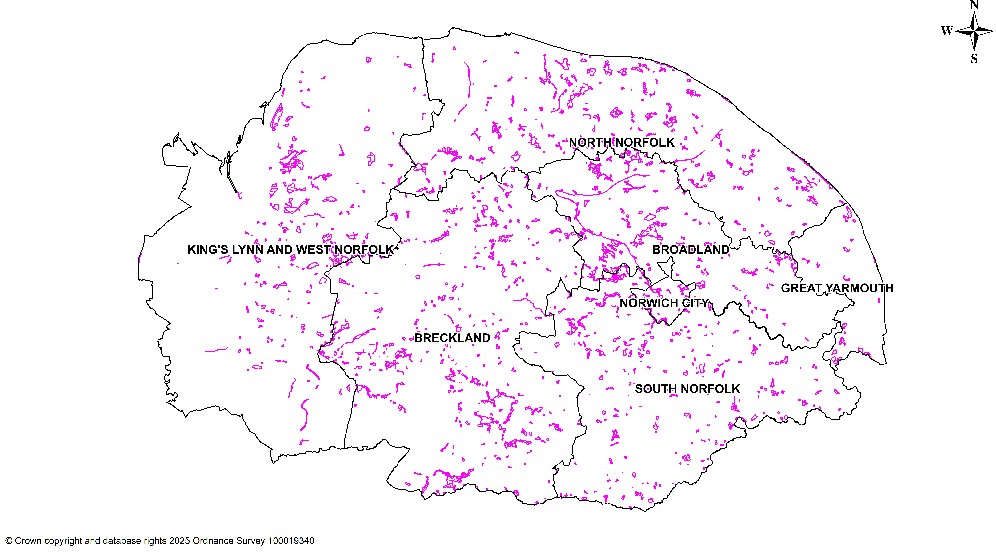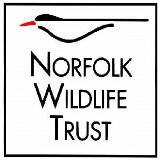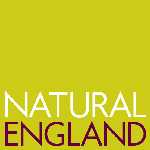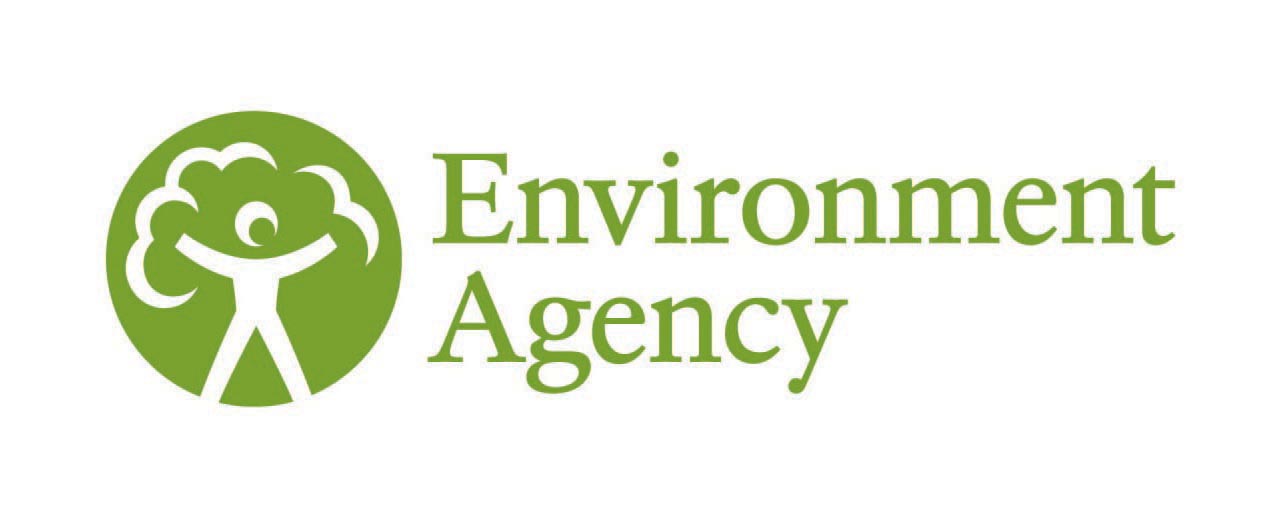What is a CWS system?
The County Wildlife Site System describes the processes involved in selecting and assessing sites, advising on management, supplying information, protecting sites, monitoring the sites and monitoring the effectiveness of the whole system.
The cornerstone of the CWS system is the Norfolk CWS Partnership, which maintains the CWS register, develops the CWS strategy and works to deliver the aims and objectives set out below.
There are 1386 CWS in Norfolk (as of Oct 2025) and in the region of 35 000 across the country. This figure is subject to change as sites are surveyed and added, deleted or modified.

Click on the map for the full size map.
For a larger scale map of CWS and other designated wildlife sites in Norfolk please download the PDF HERE
(FOR MORE INFORMATION ABOUT THE CWS SYSTEM, PLEASE READ OR DOWNLOAD THE UPDATED LOCAL SITES HANDBOOK HERE; OR READ THE CWS INFORMATION SHEET HERE).
Aims of County Wildlife Site System in Norfolk![]()
The overall aims of the County Wildlife Sites system in Norfolk are to:
- Protect, maintain and enhance the existing wildlife resource of Norfolk outside of statutory sites;
- Establish recognition of the CWS system by landowners, statutory bodies and other relevant organisations as a major tool for delivering biodiversity targets;
- Promote the role and importance of CWS at strategic level, including in the delivery of BAP targets, delivering green infrastructure, land use planning and the targeting of agrienvironment schemes;
- Encourage the sympathetic management of CWS and measures to improve habitat connectivity;
- Identify and promote funding opportunities for CWS work and management.
The CWS partnership
The purpose of the CWS system is to identify, protect and enhance the most important places for wildlife outside of the statutory designated sites. The roles of partnership are:
To co-ordinate the survey, re-survey and condition monitoring of CWS.
- To promote and support the provision of advice to CWS owners, aimed at ensuring the appropriate management of the CWS so they are in a favourable condition.
- To raise awareness of CWS and the need for appropriate management.
- To maintain the register of CWS in Norfolk and all data relevant to the register.
- To disseminate up to date information on the status of CWS in Norfolk, especially to those organisations that use the information for forward planning, development and land management advice.
Members of the CWS partnership
►Norfolk Wildlife Trust (NWT) chairs the CWS Partnership and manages the CWS system; the Trust also co-ordinates and contributes to site survey work, responding to planning consultations, raising awareness and targeting management advice. NWT is one of 45 Wildlife Trusts throughout the UK, most of which are involved in their local Wildlife Sites system. They aim to achieve the standards set out in the Wildlife Trusts' Wildlife Sites Handbook (1994), and provide input to the advancement of Wildlife Sites on a national basis.
►Natural England (NE) provides support and input to the CWS system through its role as the statutory nature conservation organisation for England. Their Position Statement on Sites of Importance to Nature Conservation (1995) is relevant to CWS. They also provide advice to landowners on a range of issues and administer the agri-environment grant schemes. Their knowledge of Norfolk and a close working relationship on the relevant grant schemes is of benefit both to CWS owners and the CWS system.
►Norfolk County Council’s (NCC) Community and Environmental Services Department, through the Natural Environment Team, contributes to the overview and running of the system and has helped with funding surveys.
►Norfolk Biodiversity Information Service (NBIS). NBIS works as a hub for the collection, collation, management and dissemination of wildlife information for the county, especially in regard to biological records. Working with NBIS ensures that the CWS system retains good links with local naturalists and recorders, as well as working together with record centre staff on the supply and gathering of vital data. NBIS produces and sends out the annual update on the CWS system, and continues to monitor the proportion of sites in positive conservation management.
►The Norfolk Biodiversity Partnership exists to produce and deliver Biodiversity Action Plans and to provide a network for the conservation agencies in Norfolk to work together in the production and delivery of these plans.
►The Environment Agency (EA) is a Government agency which aims to protect and improve rivers and riverine environments. EA participates directly in the notification and management of CWS rivers, including funding survey work.
►The Broads Authority (BA) is a statutory body with a duty to manage the Broads for biodiversity, as well as for landscape, cultural heritage and recreation. BA has contributed to the promotion and notification of County Wildlife Sites in the Norfolk Broads.
► Norfolk Farming and Wildlife Advisory Group (Norfolk FWAG) delivers expert independent advice and guidance to farmers and land managers to help them integrate best practice environmental management into their commercial farm businesses.
As well as involvement in the CWS Partnership, all of the above organisations work closely with a range of statutory and voluntary bodies to promote the importance of CWS and to deliver the central aims of safeguarding sites and encouraging the positive management of habitats. This work includes distributing CWS data and participating in biodiversity topic groups.
 |
 |
 |
|
 |
|
As well as involvement in the CWS Partnership, all of the above organisations work closely with a range of statutory and voluntary bodies to promote the importance of CWS and to deliver the central aims of safeguarding sites and encouraging the positive management of habitats. This work includes distributing CWS data and participating in biodiversity topic groups.
FOR MORE INFORMATION ABOUT THE CWS SYSTEM, PLEASE READ OR DOWNLOAD THE UPDATED LOCAL SITES HANDBOOK HERE; OR READ THE CWS INFORMATION SHEET HERE
